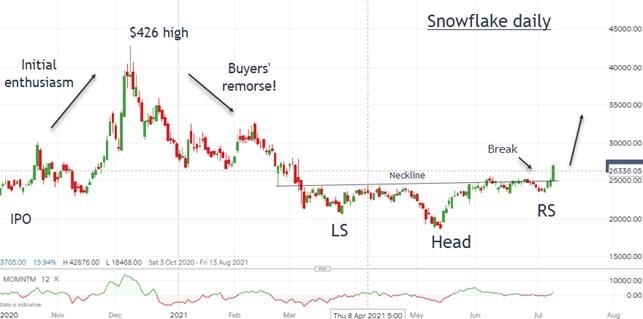Chart of the week: has this tech stock made a bullish breakout?
Our columnist looks at the price chart of an exciting cloud computing company that may be on the up.
12th July 2021 10:16
by John Burford from interactive investor
Our columnist looks at the price chart of an exciting cloud computing company that may be on the up.

Snowflake (NYSE:SNOW) is not a start-up by a group of sensitive students, but a real presence in the world of cloud computing.
Although much smaller, it is a direct competitor (and colleague) of the Alphabet (NASDAQ:GOOGL), Amazon (NASDAQ:AMZN) and Microsoft (NASDAQ:MSFT) giants who dominate that sector. I was impressed when I learned that over 50% of Fortune 500 companies use their software. So it should be treated with respect in terms of earnings growth potential.
But in common with many recent IPOs, it is still losing money. It seems many investors are only interested in money-losing outfits these days! Remember the run-up to the dot-com bubble at the millennium? A high 'burn rate' was de rigeur to generate a huge IPO valuation. Companies with actual profits were shunned.
- The IPO market in 2021 so far: winners and losers
- Top 20 most-bought US stocks so far this year
- US results preview: Q2 2021
- Want to buy and sell international shares? It’s easy to do. Here’s how
Of course, we are in a different world 20 years on. The internet has grown and matured rapidly from those early days and many companies are making real and solid businesses from it – and Snowflake is in a high-growth sector.
But it is the chart pattern that interests me – especially after Friday's action:

Past performance is not a guide to future performance.
And that advance to the $270 mark broke above the trendline that I have labelled the 'neckline' of a Head and Shoulders reversal pattern.
It had been forming since March, with the Head dipping to the $200 low. But with Friday's spurt, odds have significantly increased that the uptrend has been re-awakened.
- Chart of the week: are Apple shares about to race past record high?
- Why reading charts can help you become a better investor
- Six things you must do before buying any share
- Discover how to be a better investor here
- Check out our award-winning stocks and shares ISA
But note the price pattern after the IPO. As is usual, early bird investors drive the shares up as the initial hype enthuses many. Then, reality dawns and the hype starts to wear off and prices sag, especially when profits seem some distance away.
But that is when investors can take a calmer look at the company prospects and can be offered much better entry prices. In general, with tech valuations so high now, waiting for better prices long after an IPO often pays off.
If this is a genuine neckline break, my first main target is the $340 area with higher potential. A break below $230 would send me back to the drawing board but would probably not kill the bullish potential.
John Burford is the author of the definitive text on his trading method, Tramline Trading. He is also a freelance contributor and not a direct employee of interactive investor.
These articles are provided for information purposes only. Occasionally, an opinion about whether to buy or sell a specific investment may be provided by third parties. The content is not intended to be a personal recommendation to buy or sell any financial instrument or product, or to adopt any investment strategy as it is not provided based on an assessment of your investing knowledge and experience, your financial situation or your investment objectives. The value of your investments, and the income derived from them, may go down as well as up. You may not get back all the money that you invest. The investments referred to in this article may not be suitable for all investors, and if in doubt, an investor should seek advice from a qualified investment adviser.
Full performance can be found on the company or index summary page on the interactive investor website. Simply click on the company's or index name highlighted in the article.
Disclosure
We use a combination of fundamental and technical analysis in forming our view as to the valuation and prospects of an investment. Where relevant we have set out those particular matters we think are important in the above article, but further detail can be found here.
Please note that our article on this investment should not be considered to be a regular publication.
Details of all recommendations issued by ii during the previous 12-month period can be found here.
ii adheres to a strict code of conduct. Contributors may hold shares or have other interests in companies included in these portfolios, which could create a conflict of interests. Contributors intending to write about any financial instruments in which they have an interest are required to disclose such interest to ii and in the article itself. ii will at all times consider whether such interest impairs the objectivity of the recommendation.
In addition, individuals involved in the production of investment articles are subject to a personal account dealing restriction, which prevents them from placing a transaction in the specified instrument(s) for a period before and for five working days after such publication. This is to avoid personal interests conflicting with the interests of the recipients of those investment articles.